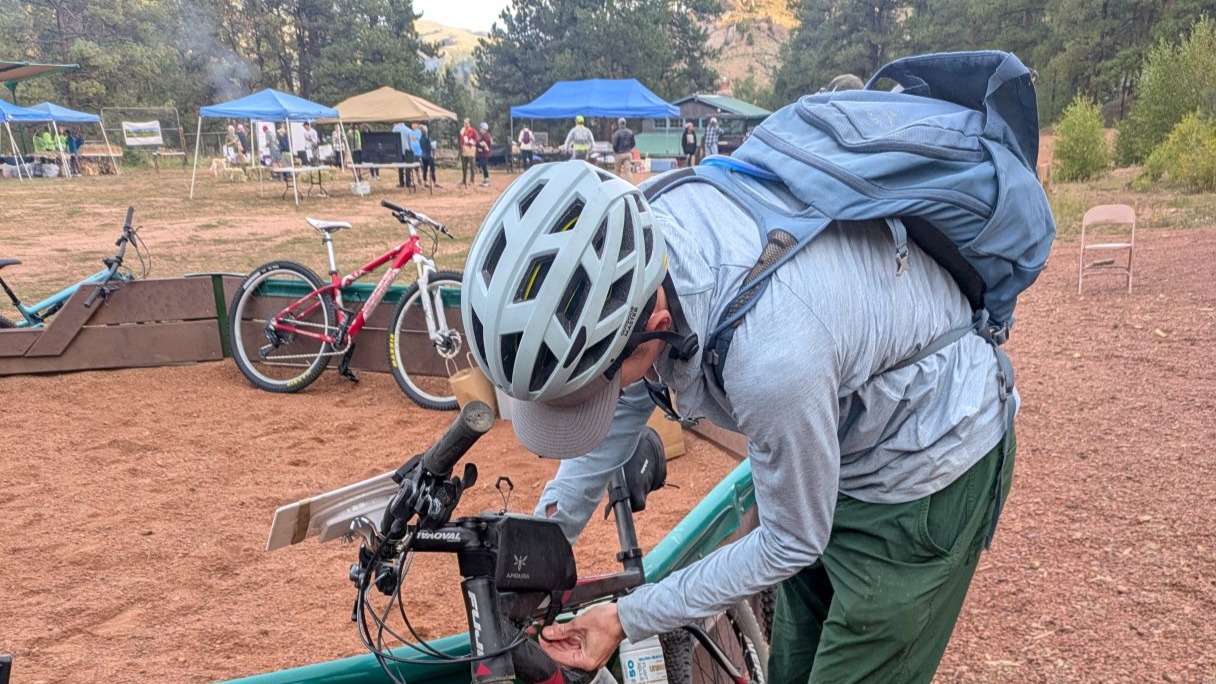After wrapping up our PNW trip and setting our sights on a potential stage race next year, Ryan and I both—without realizing it—started scouting for a fall adventure race. Turns out, we landed on the same one: Battle by the Brook, a six-hour USARA-sanctioned race in Colorado.
We were already planning a three-week trip to Colorado to see friends and break out of our Utah routine, so this race—just outside Colorado Springs—seemed perfect. It checked every box: mountain biking, trail running and paddling. Or so we thought.
Pre-Race Hype Meets Reality
We didn’t find much online about Battle by the Brook, except that it was held at a YMCA camp with staggered wave starts instead of a mass start. A few older race tags on Instagram hinted at rappelling, archery, and axe throwing. We figured it would be a fun mix of strategy and physical challenge.
Race morning arrived with perfect weather—mid-60s and partly cloudy. We ate our usual pre-race blueberry muffins, geared up, and biked to check-in. That’s when things started feeling… off.
We were handed a clue book and a “map” at check-in. The map was a blurry pictograph of the camp, every cabin labeled and no topography. Ryan immediately realized there would be zero navigation—the part of adventure racing he loves most.
Instead of a mass start, teams began every 30 seconds at different checkpoint to reduce congestion. Ours was Checkpoint 13 – two laps in a canoe on what turned out to be a small pond—maybe 250 feet across (and that’s probably generous). When Ryan jogged down to scout it out, he found canoes, kayaks, and paddleboards jammed together.
We looked at each other in disbelief and laughed. “Well, this isn’t exactly the wild adventure we were expecting.”
A Series of Short Challenges
The rest of the clue book didn’t help our optimism:
- A 1.5-mile roundtrip hike
- A three-mile mountain bike ride
- Archery
- Axe throwing
- Rappelling
- A “trail run” up the side of a steep hill/mountain
- A bike/run relay around the pond
Not exactly the adventure race we were hoping for (or used to for that matter)—but we decided to embrace it. After all, every race has its quirks, and maybe this one would surprise us.
At 8:00:30 sharp, we launched our canoe. The pond was so crowded it felt like bumper boats. Two laps later, we transitioned into the relay stage: a quick bike-and-run around the pond’s perimeter. Within 40 minutes, we’d finished three segments. We felt strong—no aches, no dehydration, no heat issues.
We started to think maybe this day would turn around.
When it Fell Apart
The fourth segment was a short mountain bike section on a gravel road leading into town, tracing a scenic river lined with fly fishermen. The terrain was fast and smooth, and for once, I was leading Ryan up a steep climb.
We returned to the start line in no time. Then it hit.
A sharp, searing pain shot up my left knee. “Oh s**t,” I said. “My IT band is done.”
There hadn’t been a warning twinge or slow build-up—it was instant and brutal. I could barely walk. Tears welled up as I tried to stretch and shake it out, but the pain only intensified.
I’ve dealt with IT band issues before—mile 24 of marathons, long runs gone too far—but this was different. It didn’t even happen while running. Somehow, the short bike leg had triggered it. I was furious and heartbroken.
We hobbled into the archery segment where teams were lined up waiting their turn. That’s when we learned another surprise: racers had to time their own waits to subtract from their total race time. A strange twist for an adventure race.
When it was our turn, we hit our targets quickly—two arrows each in the red and yellow rings—and then I tried to get back on my bike for the next segment. The pain said otherwise.
That was it. Two races this year, two DNFs.
Aftermath and Hard Lessons
I limped back to the van while Ryan officially DNF’d our team. We packed our gear, loaded the bikes, and headed to Colorado Springs for a post-race beer and some quiet commiseration. I could barely climb the restaurant stairs.
Now, two and a half weeks later, I’m still not fully recovered. Even a short walk with Matilda brings the pain back. I’ve been reminded—again—that endurance alone doesn’t prevent injuries. Strength training does.
Lesson learned:
No matter how much time we spend on bikes or trails, we can’t neglect the foundation that keeps us there. Strength training is so important to staying injury free – even if you have all the endurance in the world.
Final Thoughts
Not every adventure race is going to be epic. Some will test your patience more than your fitness. Some will end early. But even the frustrating ones teach you something—about your body, your mindset, and the value of preparing for the long game.
Battle by the Brook wasn’t the race we wanted, but it might have been the reminder we needed. And one that we’d recommend for beginners or families.

